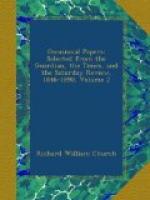Was not Mary as fully endowed as Eve?... If Eve was (as Bishop Bull and others maintain) raised above human nature by that indwelling moral gift which we call grace, is it rash to say that Mary had a greater grace?... And if Eve had this supernatural inward gift given her from the moment of her personal existence, is it possible to deny that Mary, too, had this gift from the very first moment of her personal existence? I do not know how to resist this inference:—well, this is simply and literally the doctrine of the Immaculate Conception. I say the doctrine of the Immaculate Conception is in its substance this, and nothing more or less than this (putting aside the question of degrees of grace), and it really does seem to me bound up in that doctrine of the Fathers, that Mary is the second Eve.
It seems obvious to remark that the Fathers are not even alleged to have themselves drawn this irresistible inference; and next, that even if it be drawn, there is a long interval between it and the elevation of the Mother of Jesus Christ to the place to which modern Roman doctrine raises her. Possibly, the Fathers might have said, as many people will say now, that, in a matter of this kind, it is idle to draw inferences when we are, in reality, utterly without the knowledge to make them worth anything. At any rate, if they had drawn them, we should have found some traces of it in their writings, and we find none. We find abundance of poetical addresses and rhetorical amplification, which makes it all the more remarkable that the plain dogmatic view of her position, which is accepted by the Roman Church, does not appear in them. We only find a “rudimentary doctrine,” which, naturally enough, gives the Blessed Virgin a very high and sacred place in the economy of the Incarnation. But how does the doctrine, as it is found in even their rhetorical passages, go a step beyond what would be accepted by any sober reader of the New Testament? They speak of what she was; they do not presume to say what she is. What Protestant could have the slightest difficulty in saying not only what Justin says, and Tertullian copies from him, and Irenaeus enlarges upon, but what Dr. Newman himself says of her awful and solitary dignity, always excepting the groundless assumption which, from her office in this world takes for granted, first her sinlessness, and then a still higher office in the next? We do not think that, as a matter of literary criticism, Dr. Newman is fair in his argument




